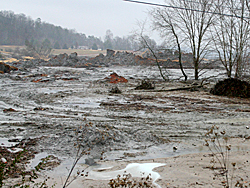New rules to regulate coal ash would close or require changes to many of the nation’s coal ash disposal sites, EPA Administrator Lisa Jackson announced today.
“This is a major step forward, at the national level, in reducing risk of improper coal ash disposal,” she said.
Regulations were originally to have been proposed in 2004, and the six-year delay reflects a heated debate between industry and public health advocates. The December 2008 Tennessee Valley Authority coal ash disaster amplified longstanding concerns.
“There are people who feel very strongly,” Jackson said. “There are equities on both sides, and what we believe would be the next best step would be to open a transparent public process.”
The regulations proposed today could take one of two approaches:
• Federal regulation of coal ash disposal, in some cases through the states (known as option “C”); or
• Weaker enforcement under federal guidelines, which EPA officials projected would lead to half as much compliance with the regulations (known as option “D”). This option would be “self-implementing” by the utilities and would not require federal permits, but would probably involve more enforcement through citizen lawsuits, EPA officials said.
In neither case would coal ash be legally considered “hazardous;” instead, it would be regulated under a special category.
However, in both cases, some of the so-called “beneficial” uses of coal ash would be curtailed, Jackson and other administration officials said. For example, use of coal ash as fill material on construction sites would be considered the same as disposal in a landfill and would require ground liners and monitoring.
Other “beneficial” uses of coal ash, for example as a fill in concrete, would still be permitted. Left open for future regulatory action was the question of coal ash disposal in mines.
Additional inspection and monitoring of 900 coal ash impoundments nationwide will also take place under both options.
Coal ash is the second largest waste product in the United States, and 120 million tons are formed from the residue of over one billion tons of coal burned each year for electricity. Numerous studies, including one in 2007 by the National Science Foundation and others by environmental organizations such as the Waterkeepers, Environmental Justice and Appalachian Voices, have shown serious contamination problems with coal ash dumping.
The utility industry and the Tennessee Valley Authority has maintained, in the face of the evidence, that coal ash is harmless. The American Coal Ash Association dismisses concerns about arsenic and other toxins–which are abundant in coal–as “fear tactics.”
Even before the TVA disaster, there were reported incidents of old fly ash deposits breaking loose, contaminating neighborhoods, threatening health and reducing property values.
The proposed regulations will be open for comment for the next three months, and avenues for public participation will be announced on the EPA web site.
More information about the proposed regulation.
View the chart comparing the Option C and Option D approaches.




Leave a Reply